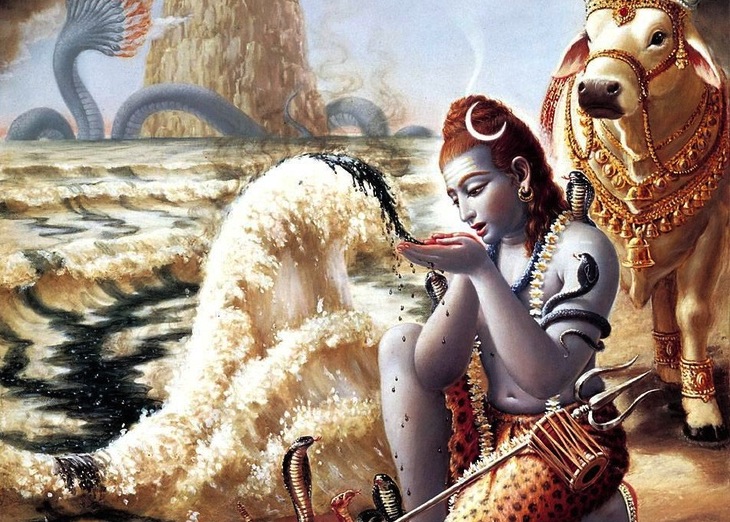
by Somya Devi | Feb 22, 2017 | Astrology, Conjunctions, Eclipses, Events, Holy Days
Healing Eclipse on the New Moon + Maha Shivaratri
Sunday begins the New Moon cycle and brings with it a powerful eclipse whose alignment offers some deep healing opportunities. The annular solar eclipse will be visible from much of Africa, South America, and Antarctica, and will coincide with the exact time of the darkest Moon phase at 6:58 a.m PST (14:58 UTC) on Sunday, February 26th. This eclipse occurs with the Sun, Moon, Mercury, and Ketu all in sidereal Aquarius within the Vedic nakshatra of Shatabisha.
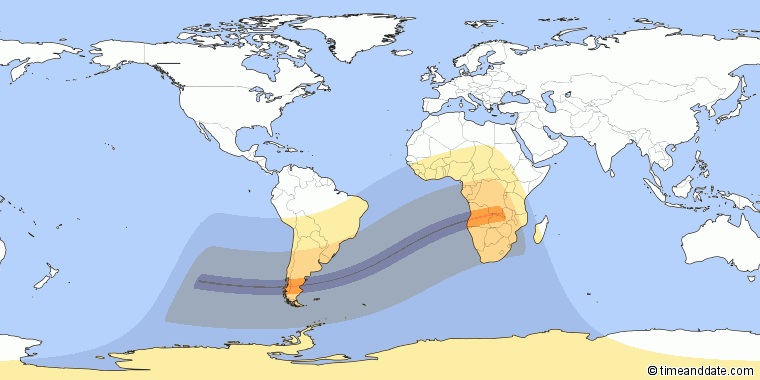
Aquarius
Aquarius is a sign ruled by Saturn, and it is where we remember something greater than ourselves. It is where we become inspired towards universal service, and to offering effort into society and for the greater good. Saturn, the planet of pressure and time, is aspecting the planets of this eclipse from his recent seat in sidereal Sagittarius, compelling us even more deeply to stand up for our principles and beliefs, and commit ourselves to these through hard work.
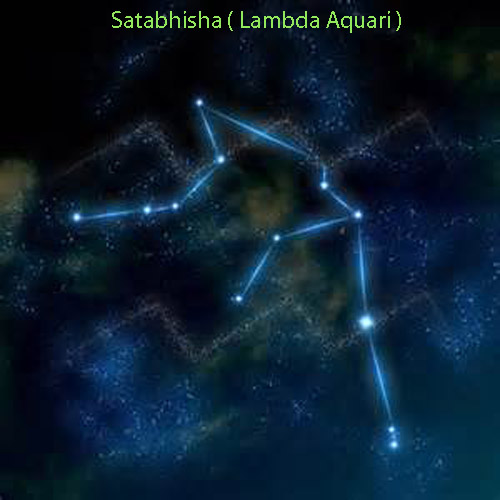
Shatabisha
Shatabisha is the Vedic nakshatra that most elicits the concept of healing. It is the star of the “100 physicians” or the “100 medicines,” and is ruled by Varuna, the deity of the cosmic waters. With many planets under the influence of this star, we are strongly called towards our journey of self-healing, trying many different medicines and healing techniques to get there. Having Ketu here, eclipsing the Sun and the Moon, presents the opportunity to go deeply into our subconscious blockages and find release from past karma and trauma.
The Greater Eclipse Cycle
This is the third solar eclipse that has occurred since Rahu and Ketu transited into the Leo-Aquarius axis in January of 2016 (download the Free E-Book and Forecast by Sign for this transit if you haven’t yet!). Throughout this time, we have experienced shadows and blockages coming up around the themes of the Leo-Aquarius axis. On a broad scale, this relates to the balance of personal power and universal service that we play out through society. On an individual level, it has raised questions around the house-themes of Leo and Aquarius in the personal Vedic birth chart.
We have been uncovering layers of our own karma through this time, and discovering where change is needed in our lives–either through a change in our actions or a change in our thoughts. Our personal challenges become most apparent during the eclipse windows, which have occurred this month, as well as during August and March of 2016. Though these windows can be difficult times, the power of the lunar nodes helps us to see where we are stuck. With self-awareness and observation it becomes less difficult, but when we are not paying attention or are clinging to our own attachments, the eclipses can feel like they are wreaking havoc on our lives.
Since this is the third and final pair of eclipses during this transit of Rahu and Ketu, it is a time for really reaching some clarity around the lessons being brought up over the last year-and-a-half. Eclipses do cause confusion and are inauspicious in general, but as we do the work of self-inquiry and practice astute awareness, we can gain insight and more light after going into the darkness of their shadows. The healing power behind Shatabisha nakshatra may present us with some different medicines, or practices, to assist in our evolutionary process, assisting us in learning how to flow better with the cosmic waters.
Shivaratri
In addition to the healing energy of this nakshatra, we are receiving the powerful gift of deep meditation offered by the Shivaratri holiday. Maha Shivaratri (or Sivaratri) is “the great night of Lord Shiva,” celebrated in India and around the world each year on the 14th night of the waning Moon this month. This year it falls on the night of Friday, February 24th into Saturday the 25th, around the world (except for mid-Australia/Japan and Eastward, where it falls on the 25th/26th).
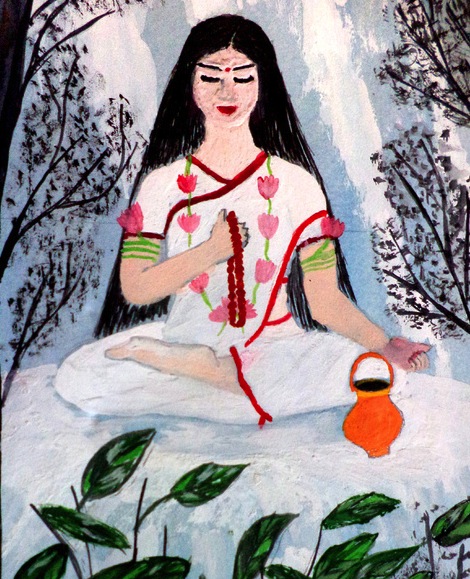 On Shivaratri, it is a common practice to stay up the whole night in meditation, fasting and praying. This commemorates the sacrifice made by Lord Shiva when he kept the poison that arose from the milk ocean in his throat in order to protect the entire creation. In this story, his wife Parvati held his throat to keep him from consuming the poison, and thus this holiday also commemorates the union of masculine and feminine forces, Shakti and Shiva, yin and yang. In many places this is represented by a celebration of Shiva and Parvati’s wedding, and one may see large statues of the two paraded about town and worshiped.
On Shivaratri, it is a common practice to stay up the whole night in meditation, fasting and praying. This commemorates the sacrifice made by Lord Shiva when he kept the poison that arose from the milk ocean in his throat in order to protect the entire creation. In this story, his wife Parvati held his throat to keep him from consuming the poison, and thus this holiday also commemorates the union of masculine and feminine forces, Shakti and Shiva, yin and yang. In many places this is represented by a celebration of Shiva and Parvati’s wedding, and one may see large statues of the two paraded about town and worshiped.
Shiva and Parvati represent the path towards awakening consciousness through the ascetic side of yoga, and the practices of tapas and renunciation. By renouncing food and sleep for one night, particularly on the night of Shivaratri, we can gain some of the benefit of the austerities that these two performed for aeons. Tapas, or austerities, are yogic practices of undergoing difficult situations in order to gain more patience, as well as deeper understanding that we are in fact the eternal soul and not the body-mind with which we normally identify.
On this Shivaratri, as we approach the transformative energy of the eclipse in Shatabisha, the opportunity for overcoming the challenges and shadows of our minds is great. The power of group meditation occurring all over the world also contributes to this. With the energy of Aquarius behind us, let us offer the fruits of our practice towards the peace and happiness of all beings on earth, and spread the benefit for the greater good.
Mantras for Maha Shivaratri:
Om Namah Shivaya (the panchakshari mantra – “I bow down to infinite consciousness”)
Tyagenaike Amrtatvamanashuhu (by renunciation alone, immortality is gained)
Personal chart readings are available to delve deeper into the meaning of this eclipse cycle in your life.
Did you like Healing Eclipse on the New Moon, following Maha Shivaratri? Please Like, Comment, and Share!

by Somya Devi | Dec 26, 2016 | Astrology, Conjunctions, Events, Retrograde
New Moon of Cosmic Waters Begins the New Year
The New Moon cycle begins on the night of December 28th, at 10:53 p.m. PST. Sun and Moon coincide in sidereal Sagittarius in Purva Ashada nakshatra, joining a retrograde Mercury. Purva Ashada is a Vedic constellation that translates as the “invincible one” or the “undefeated.” There is a powerful energy of victory associated with this star-sign, which falls in the middle of the powerful sign of Sagittarius.
The Sagittarius cycle brings an energy of optimism, as this sign is the outward expression of the planet Jupiter. Jupiter guides our philosophy and beliefs, as well as hope and optimism, so in Sagittarius we feel inspired to put our values into actions. This can inspire a lot of charitable work and humanitarian efforts. Sagittarius is also a fire sign, so we can get incredibly passionate about working for our beliefs here.
 Purva Ashada nakshatra represents the middle of the Sagittarius constellation, and is associated with both power and fluidity. The deity for this star is Apas, the deification of water. The energy of this New Moon of the cosmic waters begins the new year for us a few days later.
Purva Ashada nakshatra represents the middle of the Sagittarius constellation, and is associated with both power and fluidity. The deity for this star is Apas, the deification of water. The energy of this New Moon of the cosmic waters begins the new year for us a few days later.
In 2016 we experienced a wide-scale rising of struggles for water rights even here in the “first-world” United States. Scientists and spiritual leaders alike have told us that wars will be waged over this vital natural resource, and sadly we have reached the point where that is a reality. On the Dark Moon night of December 28th may we go inward and deeply contemplate our relationship with this elemental life-giver. Connect with Apas as the living embodiment of water if this helps you to strengthen your connection and prayers.
This could be a tough month for relationships as well as societal power struggles, because Venus, Mars, and Ketu now all join in Aquarius, opposite from Rahu in Leo. Ketu brings forth a lot of shadow energy and the combination of Ketu and Mars can be explosive. The affect of these two together with Venus could take a toll on our relationships, bringing up a lot of latent unspoken grievances and arguments about them. This is a time for self-scrutiny, as we are now approaching the last set of eclipses with Rahu and Ketu on the Leo-Aquarius axis. These eclipses will be coming in February.
Personal shadow work may be arising now, especially as we are in the middle of the last kala sarpa yoga cycle that we will experience until late next year. A kala sarpa alignment is indicated when all of the planets are on one side of the nodal axis (Rahu and Ketu are always opposite each other, forming this axis). This alignment usually brings a lot of intensity and upheaval, especially on the inner scale.
There is a range of interpretation as to whether a kala sarpa yoga occurs only when the planets are in between the nodes and not in the same sign as them, or also when they are in between the nodes and joining them within the same sign. That is to say, the current alignment may be considered a looser kala sarpa by some, or not at all by others, because Venus and Mars are in the same sign as Ketu, and Mars will soon be passing Ketu. Nevertheless, the strong proximity and association with the nodes still make for the “heavy times” energy that a kala sarpa yoga tends to bring.
This New Moon joins the Sun along with a retrograde Mercury in Sagittarius. Mercury will be retrograde until January 8th. If you’re making any travel arrangements or other plans during this period, leave yourself extra time for unexpected delays and schedule changes. It’s also a good time to go back and finish conversations that were previously unresolved.
All in all, this is a time where self-awareness is very important, largely because of the strong influence of Ketu. Ketu is one of the planets of the subconscious, so a lot of the energy arising now, in our actions, arguments, and relationships, is from a place that we do not completely understand. There is much wisdom to be gained here, however. The dark Moon time is a great time to meditate and listen to your own inner voice.Remember also to honor the water element, within and without.
*Personal 2017 Readings are available now and are being scheduled throughout the month of January. Be sure to join my mailing list to stay up-to-date with the latest 2017 forecasts
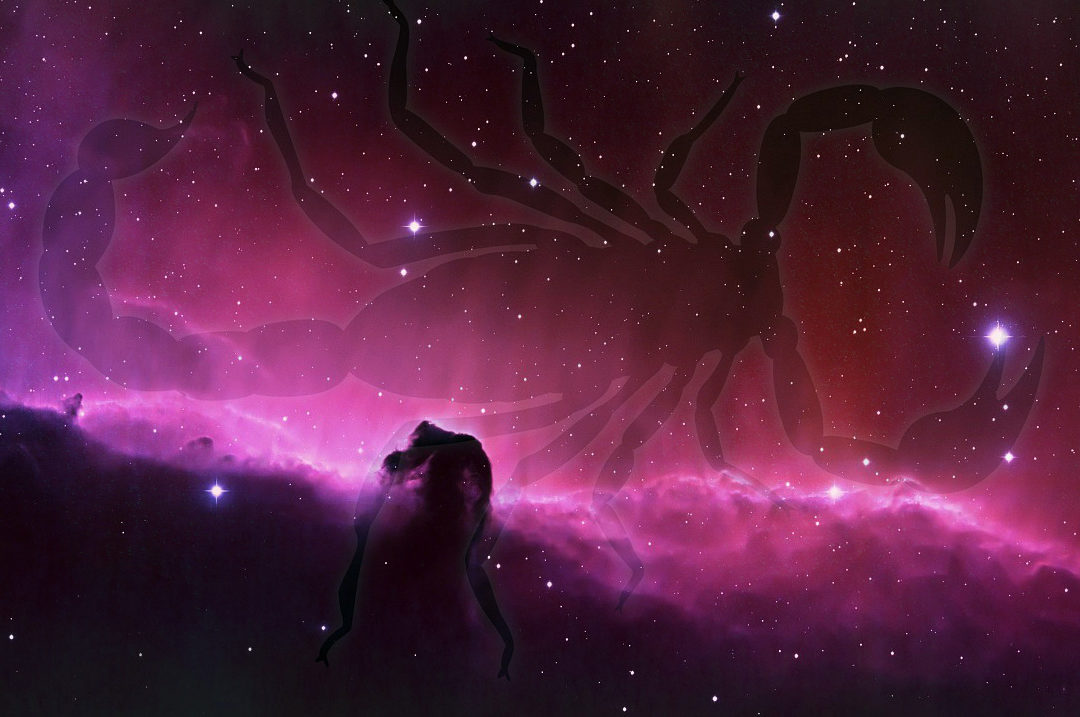
by Somya Devi | Nov 28, 2016 | Astrology, Conjunctions
On Monday night the Moon and Sun will coincide in the heart of the scorpion, leading us into a New Moon in Scorpio in the early morning. The exact conjunction will be at 4:18 am PST on the morning of November 29th. The dark Moon night is always a time to go inward, and this new Moon in particular offers the chance to go really deep. Not only are the Moon and Sun coinciding in Scorpio, a sign of depth and intensity, but they are right in the middle of a kala sarpa yoga between Rahu and Ketu.
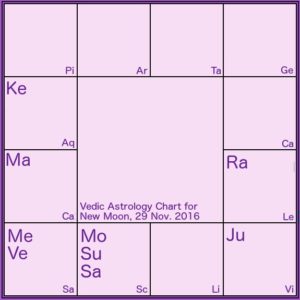 At this new Moon time, Rahu and Ketu fall at 13° of sidereal Leo and Aquarius, respectively, and Sun and Moon at 13° of Scorpio, exactly in between. A kala sarpa yoga is formed when all of the planets are on one side of the Rahu-Ketu axis, with none in the planets on the other side (see picture). This refers to the seven major planets recognized in Vedic astrology–Sun, Moon, Mars, Mercury, Jupiter, Venus, and Saturn.
At this new Moon time, Rahu and Ketu fall at 13° of sidereal Leo and Aquarius, respectively, and Sun and Moon at 13° of Scorpio, exactly in between. A kala sarpa yoga is formed when all of the planets are on one side of the Rahu-Ketu axis, with none in the planets on the other side (see picture). This refers to the seven major planets recognized in Vedic astrology–Sun, Moon, Mars, Mercury, Jupiter, Venus, and Saturn.
Kala Sarpa can be translated as either the “black snake” or the “serpent of time.” As you can imagine, whenever this alignment occurs we experience some intense or dark energy at large. One of the best words to describe the kala sarpa circumstance is heavy. The nodes, also called the shadow planets, relate to some of our deepest subconscious drives and karma. When the other planets fall on one side of their axis, a lot of the subconscious buildup can surface all of a sudden and we can feel overwhelmed with the amount that life is putting on our plate. It can also appear as the actual occurrence of intense karmic events. If we stay dedicated in practice, meditation, and focus, however, we can find clearer vision and discrimination on how we can use these circumstances for our growth.
We’ve experienced the kala sarpa yoga many times in the last year. When this alignment occurs, it lasts for two weeks at a time, from when the Moon passes Rahu until it passes Ketu, after passing all the other planets in between. This incidence will end in about a week, and then two weeks later we’ll begin the last kala sarpa cycle until late next year. Between now and then there will always be some planets on both sides of the Rahu-Ketu axis. In the late part of 2017, they will all pass Rahu and it will begin again, for two weeks at a time over a few months.
There’s even more pressure surfacing to begin this lunar cycle, because Saturn is also situated in Scorpio, joining the new Moon. It is said that when Saturn visits you, he sits on your head, like a great weight. Adding his weight to this new Moon in Scorpio, we can expect to feel some heaviness and pressure through this lunar cycle, particularly when it comes to our own inner emotions and transformational power. Saturn’s goal is to teach us how to slow down, be patient, make commitments, and persevere through hard work to reach our desired long-term goals. When we apply his energy this way in Scorpio, we can make great strides in spiritual and emotional development.
Scorpio is a feminine water sign, which brings up our inner emotions, and is ruled by Mars, the warrior planet. It is here that we face our deepest emotions and become aware of our vulnerable nature. We face the fears that are hidden deep within, and the temporary nature of all we hold dear. I think of Scorpio as the sign of the spiritual warrior, because once we become aware of these things, we can turn on Mars’ strength and courage in order to defeat these inner challenges.
Following the new Moon in Scorpio, it will be a month to get in touch with your inner warrior. Allow the passion and the tears, and use them to fortify yourself. It’s time to call upon the courage to look at our own dark sides. See the shadows in your mind that are holding you up–your fears–and strike your warrior’s sword against them.
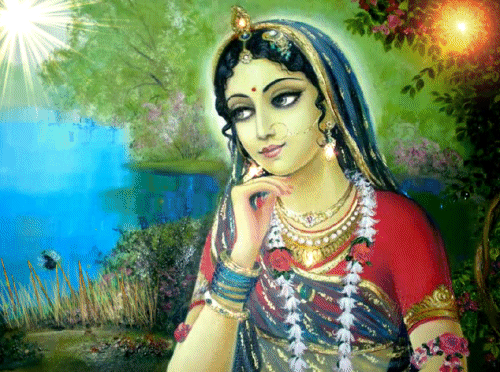 The nakshatra (Vedic constellation) where this New Moon falls is Anuradha. Anuradha makes up the middle of Scorpio, including the bright star Antares, called the heart of the scorpion. Anuradha is an incredibly devotional nakshatra. It translates as “after Radha,” Krishna’s greatest devotee. Radha is widely recognized as the paramount example of devotion, so the one who chases after her surely wishes to embody and demonstrate devotion. Saturn’s association with Anuradha will help us to persevere in our quest to strengthen ourselves and our emotions.
The nakshatra (Vedic constellation) where this New Moon falls is Anuradha. Anuradha makes up the middle of Scorpio, including the bright star Antares, called the heart of the scorpion. Anuradha is an incredibly devotional nakshatra. It translates as “after Radha,” Krishna’s greatest devotee. Radha is widely recognized as the paramount example of devotion, so the one who chases after her surely wishes to embody and demonstrate devotion. Saturn’s association with Anuradha will help us to persevere in our quest to strengthen ourselves and our emotions.
Despite the difficulty that often accompanies Scorpio, the natural eighth sign, Anuradha is a place where great blossoming is possible. It is thus associated with the symbol of the lotus, whose pure beauty springs from the depths of mud and muck. The ruling deity of Anuradha is Mitra, a god of light and friendship. This reminds us that collaboration can be useful (sometimes even necessary), despite the fiercely introverted quality that the Moon in Scorpio compels. Through devotion and effort, as well as cooperation, the lunar cycle beginning around this star can lead to great successes.
This cycle offers awesome potential for growth and achievement, especially in the realm of overcoming inner fears and strengthening our emotions. An awareness of our fragility may be surfacing acutely, but the warrior spirit of Mars and the committed potential of Saturn offer tools to forge through the fears and move closer towards our goals. Mars and Saturn are considered malefic planets, but they are actually the ones who present challenges and opportunities that will make us stronger and wiser. Take some time to sit quietly on this dark Moon night, looking inward to see where you can wield your warrior’s sword and pressure yourself aptly, in order to transform and allow your inner lotus to blossom.
Did you like New Moon in Scorpio: Pressure and Transformation? Please Like, Comment and Share!
Save
Save
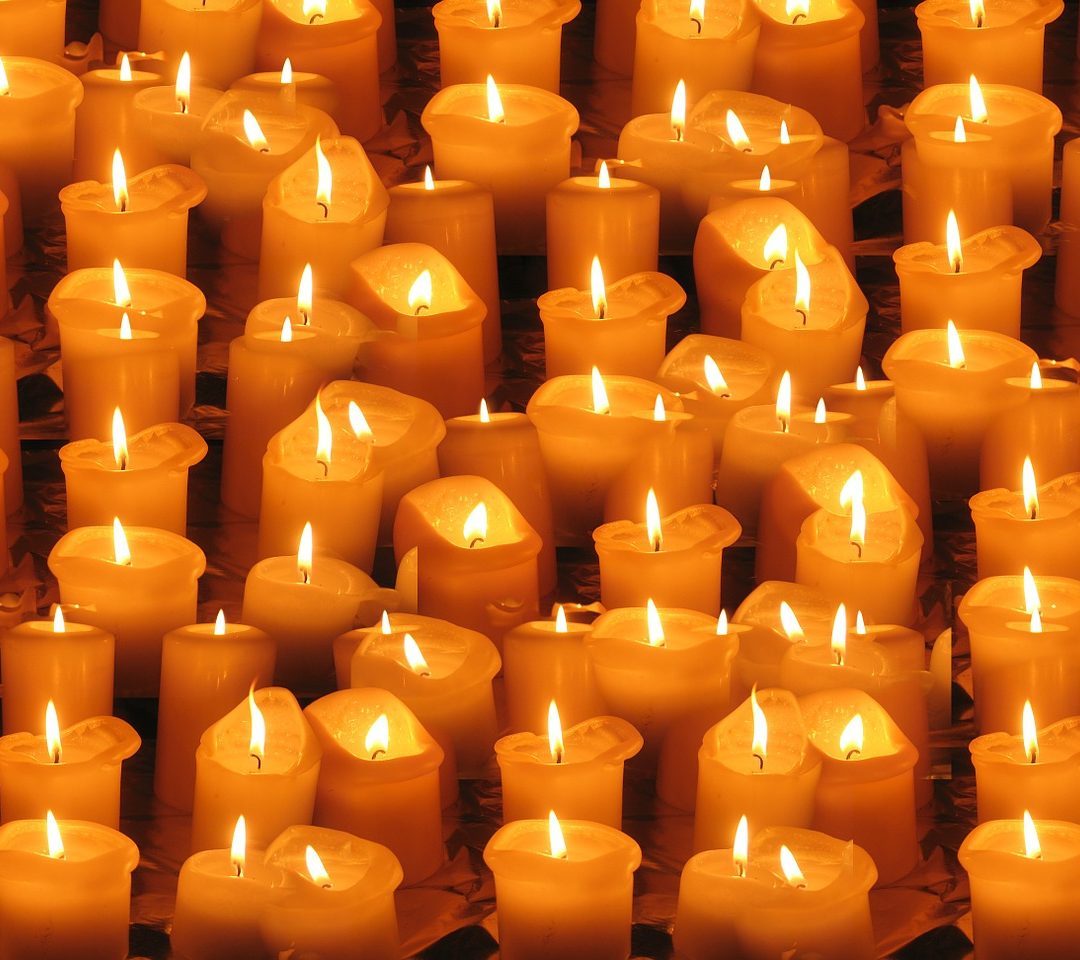
by Somya Devi | Oct 26, 2016 | Astrology, Conjunctions, Events, Holy Days
New Moon in Swati
Be careful not to become scattered this New Moon in Swati, on the dark night of Saturday, October 29th (*Times given for North America).
The Sun and Moon will coincide in this Vedic star-sign ruled by Vayu, the Lord of Wind, to kick off the next lunar cycle. The exact conjunction will be Sunday morning (at 10:38 a.m. PDT), with the darkest Moon phase on Saturday night. It will also coincide with a Venus-Saturn planetary war (exact conjunction), so we may feel a conflict between temporary pleasures and long-term goals (October 28-30). Thankfully, this dark Moon night also marks the time for celebrating Diwali (or Deepawali), the festival of light, wherein we celebrate prosperity and light prevailing over darkness! So it’s a great time to shine some light and turn our minds and hearts toward devotional practice.
Potential Depletion
There are a few factors creating the potential to feel scattered at this time, but there’s also a great opportunity to ground ourselves and steady our minds through focus and worship. In addition to Vayu’s influence, we in the Northern Hemisphere have been experiencing the cold winds increasing in the external atmosphere. As we go deeper into autumn, the vata dosha (comprised of air and ether elements) is increasing all around us. With the leaves falling and the weather changing, the process of decrease and sparsity in nature becomes evident. This results in an increase of vata energy, which can cause us to feel restless, anxious, spacey, dry, or depleted. It is extra important to do grounding and nourishing practices during this season, and to eat warm, moist, and heavier foods.***
What’s more, this lunar cycle begins with the Sun and Moon in Libra, where Sun is considered debilitated (not able to express strongly). Sun represents our vitality, energy, physical strength, and also our feeling of spiritual strength and connection with universal source. Not surprisingly, the time of year when he becomes “debilitated,” passing through Libra, is the same time we experience increased vata in the atmosphere and lessened immunity in our systems. It’s the time when we are most likely to catch a cold and begin to feel “spread thin” or “dried out.” While the Sun is in Libra, self-care is extra important. Take some time on this New Moon night to set intentions for how you will care for yourself during the coming cycle.
Another reason Sun is considered debilitated in Libra is because Libra is a sign that is very much about relationships. Sun represents our individual strength, so with Sun in Libra, we are more likely to put more of our attention on others, and on relationships, than towards our own physical health. We may be relating to our own personal power through our relationships during this time, rather than approaching it as individuals. While you are offering your love and compassion to others, don’t forget to nourish the divine within yourself as well, or you may end up feeling depleted. It is also easy to become drained when we try too hard to balance everything, another temptation of Sun in Libra.
Swati Symbolism
Thankfully, the divine universe always seems to offer just the right opportunities for solving the same challenges it presents. We just need to be willing to do the work on ourselves. This new Moon is in the part of Libra known as Swati, “the independent one,” which reminds us of our independent nature, despite the strong emphasis we may be putting on relationships at the moment. This star-sign helps remind us to look for our own inherent power, shining forth like the inner Sun.
Vayu, the wind god, is the ruler of Swati, and can bring in a restless and scattered energy to this star. He is also the father of Lord Hanuman, who is known as the greatest devotee. One lesson we learn from Hanuman is that through loving devotion, even a restless monkey mind can be tamed. He had endless devotion for Lord Rama, which gave him invincible powers to accomplish seemingly impossible tasks. Though we all have restless monkey minds at times, if we direct our attention toward love, light, or our chosen deity, we will be able to steady the mind and find immense strength within.
Practice Ideas
Some ways to still your mind through one-pointed focus include:
- Mantra recitation
- Asana practice
- Scriptural study
- Meditation on candlelight, a statue, or an image
Though a young sprout blowing in the wind (a symbol of Swati) may seem perilous, it is actually growing stronger so as to withstand the intense force of the outer circumstances. Eventually, it could grow into a tall redwood, cutting through the wind like a sword (another symbol of Swati). Swati is also related to the symbolism of a priest, which shows us the possibility for reclaiming both power and balance through devotional or spiritual practice.
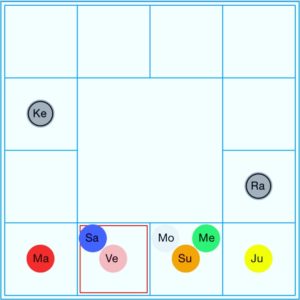 Kala Saarpa Yoga
Kala Saarpa Yoga
We may feel extra intensity seemingly out of nowhere, for the next two weeks during which the planets align in a Kala Saarpa yoga. This means that the seven major planets are all in between Rahu and Ketu, the two lunar nodes. This heavy alignment can bring up a lot of shadow work, so it is a good time to engage your toolbox for self-development. With Ketu in Shatabisha, the sign of the “hundred medicines,” alternative medicines and healing modalities can be useful towards this end.
Diwali
With all this energy in the atmosphere, enjoy the opportunity for worship offered by the advent of Diwali! This Hindu festival of light is celebrated for 6 or 7 days, with the main Diwali festival on the night of October 29th. Diwali, or Deepawali, comes from Deepa + avali, “a row of lights.”
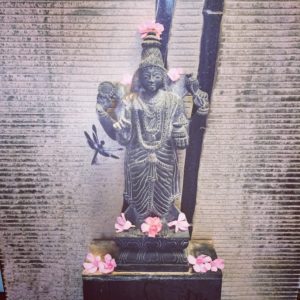 Thursday (North America) is both Dhanvantari Tryodashi (or Dhanvantari Jayanti, the birth of Lord Dhanvantari), and Dhanteras (a part of the Diwali festival). It is the thirteenth day of the waning Moon in the Vedic month of Ashwayuja. Lord Dhanvantari is known as the “father of Ayurveda” and the “physician of the Gods.” (Ayurveda is the system of natural medicine from India that is a sister science to yoga and Jyotish.) If you practice any healing tradition, especially Ayurveda, this is a good day to give thanks and call in auspicious blessings to your healing path or practice.
Thursday (North America) is both Dhanvantari Tryodashi (or Dhanvantari Jayanti, the birth of Lord Dhanvantari), and Dhanteras (a part of the Diwali festival). It is the thirteenth day of the waning Moon in the Vedic month of Ashwayuja. Lord Dhanvantari is known as the “father of Ayurveda” and the “physician of the Gods.” (Ayurveda is the system of natural medicine from India that is a sister science to yoga and Jyotish.) If you practice any healing tradition, especially Ayurveda, this is a good day to give thanks and call in auspicious blessings to your healing path or practice.
Thursday also marks Dhanteras, the first day of the Diwali festival (the Hindu festival of light). It commemorates the day that Lakshmi emerged from the milk ocean. In India, it is customary to purchase metals on this day — anything from jewelry to new statues to kitchenware (excluding iron), as a part of celebrating Lakshmi and calling in more prosperity. The metals can then be offered to your altar and will absorb and amplify the benefits of worship performed over the few days of Diwali.
It is customary to perform a puja to Lakshmi on the third night of Diwali (this Saturday in North America). Goddess Lakshmi represents wealth and prosperity (spiritual and material), as well as devotion, love, beauty, and happiness. Celebrating her on Diwali is a way to call these qualities into our lives.
It is also traditional to light candles throughout Diwali, to remind us of the divine light within. Diwali is also related to the story from the Ramayana about Lord Rama’s return from exile after fourteen years. It thus symbolizes light and goodness emerging from times of darkness. Lord Rama represents dharma, or doing our duty, as well as devotion, compassion, courage, and righteous leadership. Diwali celebrations often commemorate his and Sita’s return to the kingdom of Ayodhya after their exile.
On Saturday night as we prepare to enter the next lunar cycle, light a candle! Turn your mind toward the divine so as to focus and ground, through the practices that work best for you. Set some intentions as to how you will practice self-care during this cycle (and be sure to find me on Facebook for a live chat with tips for how to do this!).
Ram Ram, Namaste
***Be sure to Follow me on Facebook so you can tune in for my upcoming Facebook Live talks about the New Moon AND Ayurvedic tips for how to stay balanced during the high vata season!
**Limited requests for personal Vedic Astrology readings before the New Year are now available Here.
Save
Save
Save
Save
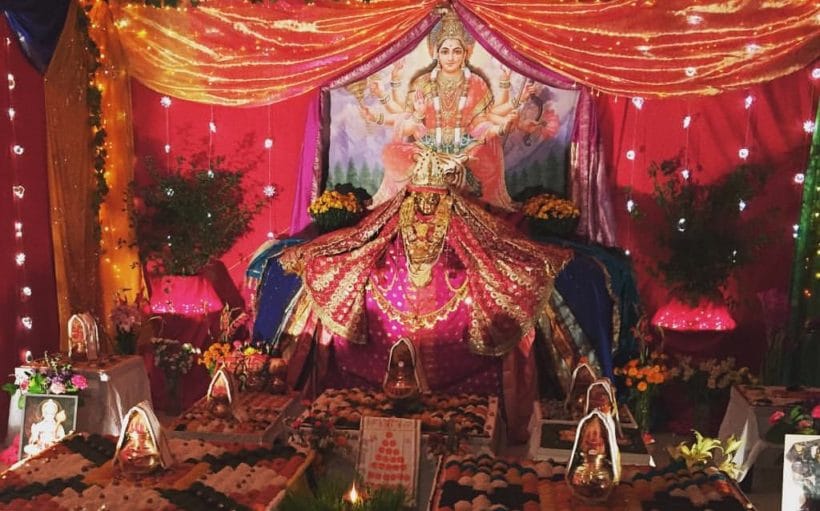
by Somya Devi | Sep 26, 2016 | Astrology, Events, Holy Days
Maha Navaratri 2016 will be from October 1st-10th, the first ten days of this new lunar cycle. In this important Hindu holiday, we celebrate the Goddess through “the great nine nights.” Goddess, Devi, Shakti, Durga, Divine Mother, the many names and forms all represent the dynamic and fluid feminine power that enlivens all of existence.
She is the creatrix, the warrioress, the nurturer, the purifyer, the protector. While she’s in the innocent and fertile maiden so is she the wise and learned crone. Both the nurturing mother, and the one who gives “tough love.” The impassioned lover, the devoted bhakta, the disciplined yogini. We see Goddess appear through us in innumerable manifestations. Through her many forms she teaches us and offers us countless blessings–love, compassion, courage, learning, discipline, surrender, success, enlightenment, and bliss. This festival is a time for celebrating the supreme feminine power in all her glory, and the many blessings she bestows upon us.
As with most Hindu celebrations, this festival correlates with the lunar calendar, and thus begins on the first day of the waxing Moon after the New Moon of September 30th. The celebration is through the “nine nights” of October 1-9, 2016, and into the tenth morning known as Vijayadashami, “the day of victory,” on October 10th. Worship during Navaratri is most generally dedicated to Goddess in the form of Durga, the demon-slayer, but there is much nuance and variation to practice and forms of celebration throughout India. Above all, Navaratri is a community celebration of the Divine Mother, and the love, abundance and protection she gives.
There are many Navaratri celebrations throughout the year, but the fall-time Navaratri is the most widely celebrated, and is thus called Maha Navaratri – “the great nine nights”. It correlates with the time of the harvest, a time to give thanks for the abundance of the year’s work. Grains and crops are often offered to Devi as part of the celebrations. Ritualistic worship (puja) typically occurs in homes and temples throughout the nine nights and into the tenth morning of celebration.
The Many Forms of Goddess
Durga-Lakshmi-Sarasvati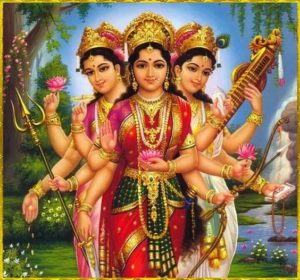
In Kerala and other places in India, the first three nights of worship are dedicated to Durga (the invincible), the next three to Lakshmi (Goddess of prosperity), and the final three to Sarasvati (Goddess of learning). Durga helps us to destroy and remove the negative tendencies in our minds and hearts, freeing us from the obstructions to our spiritual and material pursuits. Lakshmi helps us to cultivate positive qualities like compassion and devotion, and leads us towards both spiritual and material prosperity. Sarasvati assists us in attaining knowledge and wisdom, through the illumination of our consciousness. She aids in awakening sattva, the quality of purity, and the flow of prana, the vital breath. After removing inner and outer obstacles and cultivating prosperity through virtuous qualities, our devotion, service, and practice help us to attain a state of peace, bliss, and oneness.
Sarasvati-Lakshmi-Kali/Durga
In the Kali Kula (Kali school of worship) in northeastern India, Sarasvati is worshiped on the first three nights, followed by Lakshmi and then Kali/Durga on the last three. Sarasvati, Lakshmi, and Kali/Durga (Kali emerged from Durga) are also known as the consorts of Brahma, Vishnu, and Shiva. The Goddesses, therefore, provide the shakti to the cosmic processes of creation, preservation, and death/transformation, similar to their male counterparts. Consequently, worship in this manner is dedicated to the cycles of life and Mother nature, through birth, then sustenance, then death. Death is not a complete stop, but allows for the regeneration of energy into a new cycle once again.
9 Forms of Goddess
Throughout India, the nine nights of Navaratri are often dedicated to 9 different incarnations of Durga, allowing the worship of many different aspects of Shakti in a gradual evolution. You can read the stories and significance of these 9 goddesses here, or a more a brief introduction, here:
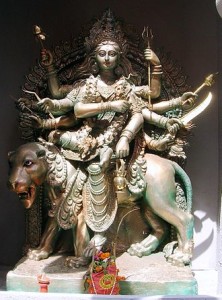 1. Shailputri
1. Shailputri
“Daughter of the mountain”; creative energy, muladhara (root chakra), awakening; Awaken your connection with Goddess today or initiate a new venture, calling on Shailputri for new beginnings.
2. Brahmacharini
The ascetic; tapas, discipline, devotion, strength, wisdom, creative abundance; Good day for fasting and meditation, connection with svadhistana (sacral chakra).
3. Chandraghanta
Warrioress; protection, courage, grace, manipura (solar plexus); Destroy your internal obstacles by offering them to Chandraghanta.
4. Kushmanda
Creatrix of the “cosmic egg”; strength, health, happiness, success, relationships; Connect with the vital Sun energy and the anahata (heart chakra) today.
5. Skandamata
“Mother of Skanda/Kartikeya”; motherly love, nourishment, protection, purity; Call on divine truth through the vishuddha (throat chakra), invoking Skandamata to lead you towards victory.
6. Katyayani
Warrioress who destroyed Mahishasura (the buffalo demon); victory, devotion, strength, removing obstacles; Meditate on these qualities of Goddess through the ajna chakra (third-eye) today.
7. Kalaratri
“Dark/black night,” representing a fierce form of Durga/Kali; darkness, death, surrender, dissolution of pain; Connecting with the sahasrara (crown chakra), remember that Divine Mother offers love, compassion, and many blessings even in hard times. Even in the midst of apparent darkness, and helps us to go beyond the boundaries of the material body-mind and connect with spirit.
8. Mahagauri
“Great white goddess”; detachment, purification, renewal, protection, virtue; Through detachment and devotion, we emerge purified, shining and radiant after surrendering in the dark night. Rejuvenative herbs and foods are good today.
9. Siddhidatri
Goddess of “siddhis”; magical, spiritual or mystic powers and blessings, fulfillment of desires, devotion, divine union; Invite Goddess to reveal her presence to you everywhere and in every moment.
Personal Practice Ideas for Navaratri
If possible, it is great to reduce our workload and gather with community at local temples or places of worship. We can also create a little time and space at home and conduct some personal practices to celebrate Goddess energy. Here are some ideas to do at home or with a group throughout the nine nights of Navaratri:
Altar
Create a sacred space, a Durga altar, or a Goddess altar. Even if you already have one, you can refresh it in some way or rearrange it specifically for Navaratri. Include images or statues of the Goddess(es) you have a relationship with. This could be according to one of the groups of forms above.
Invocation
Even if you don’t have much time, dedicate at least a few minutes each day to connecting with the Divine Mother in front of your altar.
Journal
Write in your journal about what qualities of Goddess you perceive and connect with. What aspects would you like to strengthen or to cultivate more deeply? Write any and all prayers and offer them to the form of Goddess that appeals to you.
Light
Offer light to illuminate Goddess’s power, helping her to shine more brightly into the world and your life. You can light a candle by the altar and keep it burning when you’re at home. You can even keep an electronic tealight on symbolically when you are away.
Flowers/Grains
Offer flowers or grains (even a small dish of dried rice) to celebrate Devi in the form of mother nature, fertility, the abundance of the harvest, and the cycle of life.
Offerings
Offer incense, bells, water, or food if you feel called, by placing it on the altar, or mentally offering it to Goddess throughout the day. You can also offer something symbolic of your own work or practice, whatever you have been cultivating for harvest through the year. In offering this you surrender the fruits of your efforts to the Divine Mother.
Fasting
Some people choose to fast in some variation, if this is something you have practiced before. This might include fasting during the day, fasting with only milk or fruit, or abstaining from alcohol and non-vegetarian foods during Navaratri.
Chanting
Chanting the Devi Mahatmyam, a verse to the Goddess, is a common practice during the nine-night festival. You can also chant another Goddess mantra or songs that are special to you and your relationship with Devi.
JAI MA DURGA!
Personal Vedic Astrology chart readings and forecasts are available Here.
Did you like Maha Navaratri 2016? Please Like, Comment and Share!
Save
Save
Save



 On Shivaratri, it is a common practice to stay up the whole night in meditation, fasting and praying. This commemorates the sacrifice made by Lord Shiva when he kept the poison that arose from the milk ocean in his throat in order to protect the entire creation. In this story, his wife Parvati held his throat to keep him from consuming the poison, and thus this holiday also commemorates the union of masculine and feminine forces, Shakti and Shiva, yin and yang. In many places this is represented by a celebration of Shiva and Parvati’s wedding, and one may see large statues of the two paraded about town and worshiped.
On Shivaratri, it is a common practice to stay up the whole night in meditation, fasting and praying. This commemorates the sacrifice made by Lord Shiva when he kept the poison that arose from the milk ocean in his throat in order to protect the entire creation. In this story, his wife Parvati held his throat to keep him from consuming the poison, and thus this holiday also commemorates the union of masculine and feminine forces, Shakti and Shiva, yin and yang. In many places this is represented by a celebration of Shiva and Parvati’s wedding, and one may see large statues of the two paraded about town and worshiped.

 Purva Ashada nakshatra represents the middle of the Sagittarius constellation, and is associated with both power and fluidity. The deity for this star is Apas, the deification of water. The energy of this New Moon of the cosmic waters begins the new year for us a few days later.
Purva Ashada nakshatra represents the middle of the Sagittarius constellation, and is associated with both power and fluidity. The deity for this star is Apas, the deification of water. The energy of this New Moon of the cosmic waters begins the new year for us a few days later.
 At this new Moon time, Rahu and Ketu fall at 13° of sidereal Leo and Aquarius, respectively, and Sun and Moon at 13° of Scorpio, exactly in between. A kala sarpa yoga is formed when all of the planets are on one side of the Rahu-Ketu axis, with none in the planets on the other side (see picture). This refers to the seven major planets recognized in Vedic astrology–Sun, Moon, Mars, Mercury, Jupiter, Venus, and Saturn.
At this new Moon time, Rahu and Ketu fall at 13° of sidereal Leo and Aquarius, respectively, and Sun and Moon at 13° of Scorpio, exactly in between. A kala sarpa yoga is formed when all of the planets are on one side of the Rahu-Ketu axis, with none in the planets on the other side (see picture). This refers to the seven major planets recognized in Vedic astrology–Sun, Moon, Mars, Mercury, Jupiter, Venus, and Saturn. The nakshatra (Vedic constellation) where this New Moon falls is Anuradha. Anuradha makes up the middle of Scorpio, including the bright star Antares, called the heart of the scorpion. Anuradha is an incredibly devotional nakshatra. It translates as “after Radha,” Krishna’s greatest devotee. Radha is widely recognized as the paramount example of devotion, so the one who chases after her surely wishes to embody and demonstrate devotion. Saturn’s association with Anuradha will help us to persevere in our quest to strengthen ourselves and our emotions.
The nakshatra (Vedic constellation) where this New Moon falls is Anuradha. Anuradha makes up the middle of Scorpio, including the bright star Antares, called the heart of the scorpion. Anuradha is an incredibly devotional nakshatra. It translates as “after Radha,” Krishna’s greatest devotee. Radha is widely recognized as the paramount example of devotion, so the one who chases after her surely wishes to embody and demonstrate devotion. Saturn’s association with Anuradha will help us to persevere in our quest to strengthen ourselves and our emotions.




